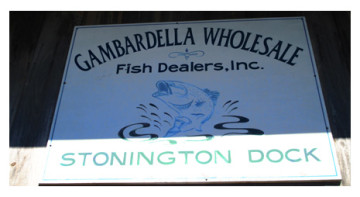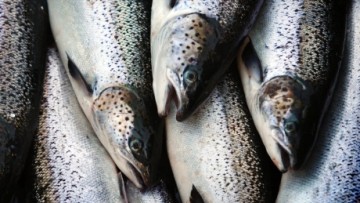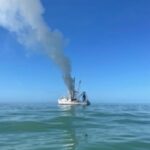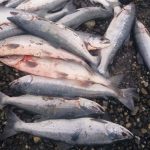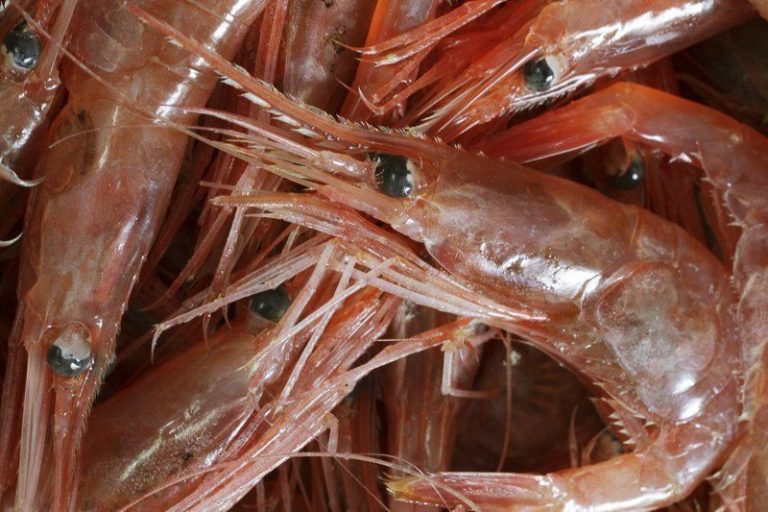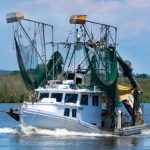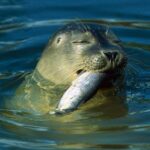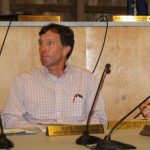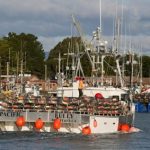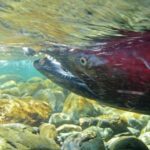Monthly Archives: April 2016
The Western Flyer – known as the Gemini during her Homer fishing years
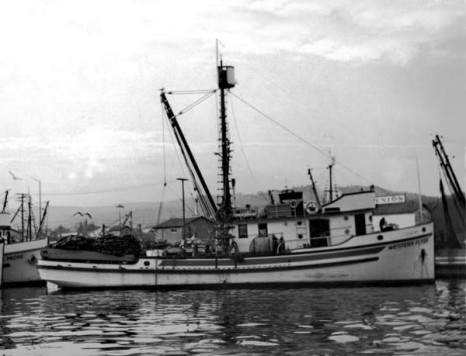 A phone call from former crew member Jim Herbert informed David and Dennis Fry that the boat they fished on in the 1970s with their father was the Western Flyer — the vessel on which author John Steinbeck took the expedition chronicled in the book, “The Log from the Sea of Cortez.” In an intriguing turn of the tide, Dennis Fry will speak at a symposium about the Western Flyer that will be live-streamed on YouTube on Saturday, April 16, from 8 a.m. to 4 p.m., Alaska Daylight Time. To the Frys, the boat was the Gemini, David said. They knew a previous owner had changed the boat’s name from the Western Flyer, but they were unaware of the significance. Read the article here 16:48
A phone call from former crew member Jim Herbert informed David and Dennis Fry that the boat they fished on in the 1970s with their father was the Western Flyer — the vessel on which author John Steinbeck took the expedition chronicled in the book, “The Log from the Sea of Cortez.” In an intriguing turn of the tide, Dennis Fry will speak at a symposium about the Western Flyer that will be live-streamed on YouTube on Saturday, April 16, from 8 a.m. to 4 p.m., Alaska Daylight Time. To the Frys, the boat was the Gemini, David said. They knew a previous owner had changed the boat’s name from the Western Flyer, but they were unaware of the significance. Read the article here 16:48
Juneau’s Docks and Harbors Board debates commercial fishing moorage discount
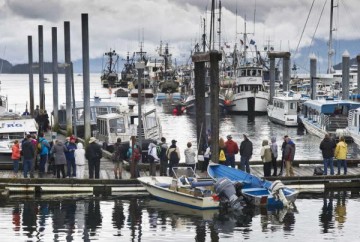 Juneau’s Docks and Harbors Board is working to revise a portion of city code pertaining to a commercial fishing moorage discount that some people have argued is unfair. But after an hour-long discussion during its meeting Wednesday, the board hadn’t decided what it plans to do with the discount. “I’m fairly new to the fishing community, but I was shocked last year when I went to Statter Harber,” Blattner told the board during a brief public testimony. He said he expected to receive the moorage discount, but he was ineligible because he didn’t sell his catch to a Juneau fish processing company. “It kind of felt like a slap in the face. You’re telling me who to sell to, and that’s what it comes down to. It’s deal I can’t refuse.” Fishermen who want the discount have to sell to one of two companies: Alaska Glacier Seafoods Inc. or Taku Smokeries. Read the article here 16:18
Juneau’s Docks and Harbors Board is working to revise a portion of city code pertaining to a commercial fishing moorage discount that some people have argued is unfair. But after an hour-long discussion during its meeting Wednesday, the board hadn’t decided what it plans to do with the discount. “I’m fairly new to the fishing community, but I was shocked last year when I went to Statter Harber,” Blattner told the board during a brief public testimony. He said he expected to receive the moorage discount, but he was ineligible because he didn’t sell his catch to a Juneau fish processing company. “It kind of felt like a slap in the face. You’re telling me who to sell to, and that’s what it comes down to. It’s deal I can’t refuse.” Fishermen who want the discount have to sell to one of two companies: Alaska Glacier Seafoods Inc. or Taku Smokeries. Read the article here 16:18
Washington rep, trawlers scuttle rumors of Gulf legislation
 A Washington congresswoman’s office and members of the North Pacific trawl industry deny rumors that they are collaborating on federal fishing legislation that would circumvent the North Pacific Fishery Management Council process. The North Pacific Fishery Management Council regulates federal fisheries from three to 200 miles off the Alaska coast. Currently, the council is considering a regulatory package of several options to implement a quota share system for Gulf of Alaska groundfish fisheries, one of the last remaining North Pacific fisheries without such a system. Word surfaced that a Washington legislator had crafted language at the behest of the trawl industry to implement a preferred industry alternative at the congressional level. Read the rest here 13:54
A Washington congresswoman’s office and members of the North Pacific trawl industry deny rumors that they are collaborating on federal fishing legislation that would circumvent the North Pacific Fishery Management Council process. The North Pacific Fishery Management Council regulates federal fisheries from three to 200 miles off the Alaska coast. Currently, the council is considering a regulatory package of several options to implement a quota share system for Gulf of Alaska groundfish fisheries, one of the last remaining North Pacific fisheries without such a system. Word surfaced that a Washington legislator had crafted language at the behest of the trawl industry to implement a preferred industry alternative at the congressional level. Read the rest here 13:54
Western Isles flotilla searches for missing Louisa skipper
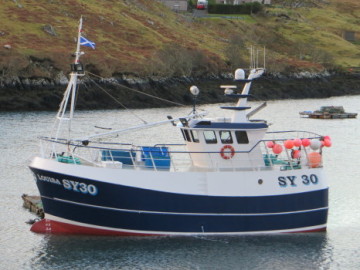 A flotilla of boats is taking part in a search for the skipper of the Louisa, which sank of Mingulay. Paul Alliston, who is also known locally as Paul MacMillan, was last seen swimming for land after the fishing boat went down on Saturday. One member of the crew, Lachlann Armstrong, was rescued but his colleagues Chris Morrison and Martin Johnstone died. A large number of people have volunteered to take part in the search. The operation is being co-ordinated by the police, coastguard and RNLI. Read the story here 10:40
A flotilla of boats is taking part in a search for the skipper of the Louisa, which sank of Mingulay. Paul Alliston, who is also known locally as Paul MacMillan, was last seen swimming for land after the fishing boat went down on Saturday. One member of the crew, Lachlann Armstrong, was rescued but his colleagues Chris Morrison and Martin Johnstone died. A large number of people have volunteered to take part in the search. The operation is being co-ordinated by the police, coastguard and RNLI. Read the story here 10:40
Ilwaco CFA meeting – Out-of-region experts from Cape Cod explain a new path for fisheries
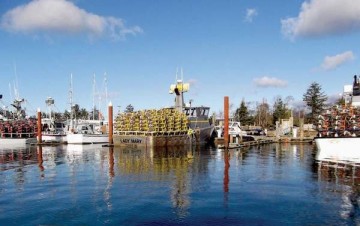 Ed Backus of Collaborative Fisheries Associates said there is no cookie-cutter approach to CFAs and similar entities like fishing-quota banks. Pointing to organizations in California and Massachusetts, Backus said CFAs can be tailored to different fisheries and goals. Presenting talks at the Ilwaco CFA meeting were Paul Parker, director of Cape Cod Commercial Fishermen’s Alliance, and Capt. Jeremiah O’Brien, member and former president of the Morro Bay Commercial Fishermen’s Organization and the Morro Bay Community Quota Fund. The CFA took on $2.5 million in initial debt to acquire fishing rights and paid about half back in five years, Parker said. Initial participants are doing very well, primarily in the Cape Cod scallop fishery, he said. The CFA’s investment in groundfish quota hasn’t proven as useful,,, Read the article here 09:53
Ed Backus of Collaborative Fisheries Associates said there is no cookie-cutter approach to CFAs and similar entities like fishing-quota banks. Pointing to organizations in California and Massachusetts, Backus said CFAs can be tailored to different fisheries and goals. Presenting talks at the Ilwaco CFA meeting were Paul Parker, director of Cape Cod Commercial Fishermen’s Alliance, and Capt. Jeremiah O’Brien, member and former president of the Morro Bay Commercial Fishermen’s Organization and the Morro Bay Community Quota Fund. The CFA took on $2.5 million in initial debt to acquire fishing rights and paid about half back in five years, Parker said. Initial participants are doing very well, primarily in the Cape Cod scallop fishery, he said. The CFA’s investment in groundfish quota hasn’t proven as useful,,, Read the article here 09:53
Terrebonne sales tax exemption for commercial fishing requested
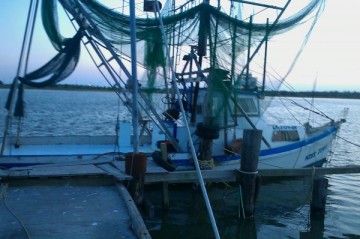 As commercial fishermen deal with low prices, they are trying to find ways to make ends meet. Kim Chauvin, co-owner of Mariah Jade Seafoood and David Chauvin’s Seafood, asked the Terrebonne Parish Council tonight to consider a sales tax exemption for commercial fishermen similar to the exemption they had been getting from the state. The state provided an exemption if their income is over 50 percent from commercial fishing. The exemption was removed during the special session Gov. John Bel Edwards called in February to close the current fiscal year’s budget gap. Chauvin said commercial fishing brings in about $230 million to the parish. “We do have some (fishermen) that would bring value to this and it would help them out at this time,” she said. Read the rest here 07:27
As commercial fishermen deal with low prices, they are trying to find ways to make ends meet. Kim Chauvin, co-owner of Mariah Jade Seafoood and David Chauvin’s Seafood, asked the Terrebonne Parish Council tonight to consider a sales tax exemption for commercial fishermen similar to the exemption they had been getting from the state. The state provided an exemption if their income is over 50 percent from commercial fishing. The exemption was removed during the special session Gov. John Bel Edwards called in February to close the current fiscal year’s budget gap. Chauvin said commercial fishing brings in about $230 million to the parish. “We do have some (fishermen) that would bring value to this and it would help them out at this time,” she said. Read the rest here 07:27
Controversial National Marine Sanctuary Proposed for Sandy Hook Region
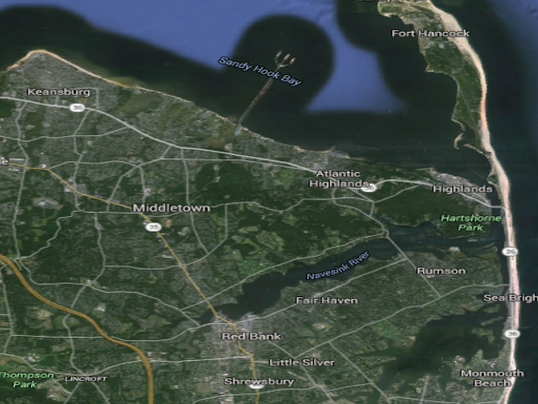 Rik van Hemmen, a marine engineer based in Red Bank, has proposed to turn a corner of northeastern Monmouth County into a national marine sanctuary. The sanctuary, tentatively called the Sandy Hook Bay National Marine Sanctuary, would stretch from the Navesink and Shrewsbury rivers and around Sandy Hook and the Sandy Hook Bay. However, Monmouth County fishermen are vehemently opposed to the idea, which they say would very likely result in restrictions or even bans on fishing and clamming in the Sandy Hook region. “We have all federal, local and state layers of protection. The marine sanctuary doesn’t make it any stronger. All it does is, it’s going to restrict traditional user groups such as recreational and commercial fishermen, duck hunters, clammers, etc.” Jim Donofrio, director of the Recreational Fishing Alliance, told the APP. Read the rest here 07:06
Rik van Hemmen, a marine engineer based in Red Bank, has proposed to turn a corner of northeastern Monmouth County into a national marine sanctuary. The sanctuary, tentatively called the Sandy Hook Bay National Marine Sanctuary, would stretch from the Navesink and Shrewsbury rivers and around Sandy Hook and the Sandy Hook Bay. However, Monmouth County fishermen are vehemently opposed to the idea, which they say would very likely result in restrictions or even bans on fishing and clamming in the Sandy Hook region. “We have all federal, local and state layers of protection. The marine sanctuary doesn’t make it any stronger. All it does is, it’s going to restrict traditional user groups such as recreational and commercial fishermen, duck hunters, clammers, etc.” Jim Donofrio, director of the Recreational Fishing Alliance, told the APP. Read the rest here 07:06
Morro Bay opts not to host second Marine Sanctuary forum
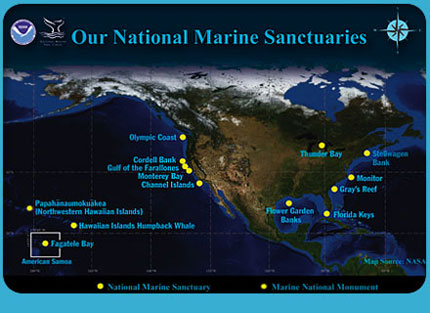 The proposed Chumash Heritage National Marine Sanctuary would stretch 140 miles along the coast from Cambria to Santa Barbara. The proposal has been nominated, meaning it’s in the queue for consideration, but no formal designation process has begun yet. The proposal’s concept is to protect a diverse ecosystem from oil drilling, seismic surveys and other potential impacts, while encouraging scientific research. Coastal wildlife includes dolphins, whales, white sea bass, sardines, mackerel, kelp and elephant seals. Fishing industry leaders, however, are concerned that a sanctuary would lead to more fishing restrictions and believe existing governmental protections — such as trawl closure areas, rockfish conservation areas and marine-protected areas — are sufficient. They also believe that adding a new federal regulating agency would reduce local influence over offshore policy. Read the rest here 06:47
The proposed Chumash Heritage National Marine Sanctuary would stretch 140 miles along the coast from Cambria to Santa Barbara. The proposal has been nominated, meaning it’s in the queue for consideration, but no formal designation process has begun yet. The proposal’s concept is to protect a diverse ecosystem from oil drilling, seismic surveys and other potential impacts, while encouraging scientific research. Coastal wildlife includes dolphins, whales, white sea bass, sardines, mackerel, kelp and elephant seals. Fishing industry leaders, however, are concerned that a sanctuary would lead to more fishing restrictions and believe existing governmental protections — such as trawl closure areas, rockfish conservation areas and marine-protected areas — are sufficient. They also believe that adding a new federal regulating agency would reduce local influence over offshore policy. Read the rest here 06:47
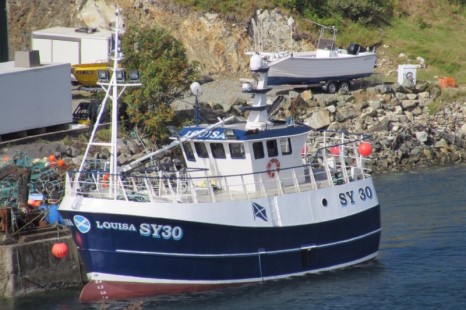
MFV LOUISA Crew family fund
Following the devastating tragedy of LOUISA going down on 4/9/16, and losing 2 crewmen, one still missing and one recovering, I’d really like to set up this fund for all of the families who are involved and suffering at this awful time. It has hit the Western Isles hard, as well as the rest of scotland and further afield. My thoughts are with the owners of Louisa also, who were not aboard at the time. Feel free to donate as much or as little as you’d like. The funds will go towards burials for the boys and help the families who are having to go through this very very sad time. RIP boys. Lorraina Matheson is the fund sponsor. In loving memory for Fishermen Paul Alliston, Chris Morrison, and Martin Johnstone. Click here 13:24
Athearn Marine Agency Boat of the Week: 45′ Stanley Lobster boat, 325HP, 8 Cylinder Detroit
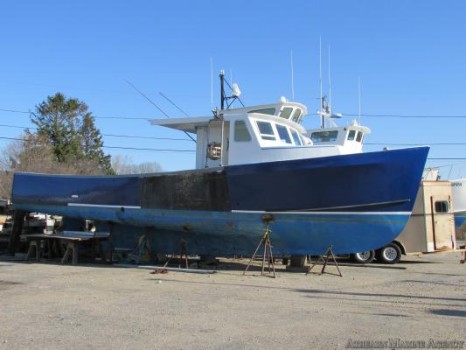 Specifications, information and 15 photo click here To see all the boats in this series, Click here 12:29
Specifications, information and 15 photo click here To see all the boats in this series, Click here 12:29
The secretive and slippery world of glass eel fishing
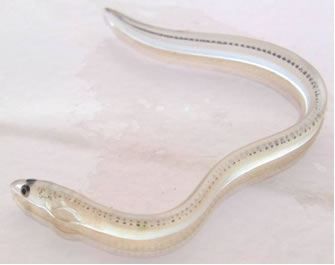 The night before my scheduled interview with a fisherman, I get a text that reads: “sorry decided not to do article can’t help our suffering fishery please don’t use my info.” When I ask if his buyer will at least speak to me, I’m told he’s out too. Another man relays the message that even if I were his brother and writing this article, he wouldn’t be a part of it. No one else is willing to talk. There isn’t anything illegal going on here, but I may as well be talking about Watergate. My (now completely anonymous) source is an uncooperative version of Deep Throat. Or maybe he’s Deep Sea Throat, because the taboo subject that’s got these insiders so buttoned up is eels. Specifically, elver eels. Read the article here 11:09
The night before my scheduled interview with a fisherman, I get a text that reads: “sorry decided not to do article can’t help our suffering fishery please don’t use my info.” When I ask if his buyer will at least speak to me, I’m told he’s out too. Another man relays the message that even if I were his brother and writing this article, he wouldn’t be a part of it. No one else is willing to talk. There isn’t anything illegal going on here, but I may as well be talking about Watergate. My (now completely anonymous) source is an uncooperative version of Deep Throat. Or maybe he’s Deep Sea Throat, because the taboo subject that’s got these insiders so buttoned up is eels. Specifically, elver eels. Read the article here 11:09
Alaska’s Commercial salmon harvest expected to be leaner this summer
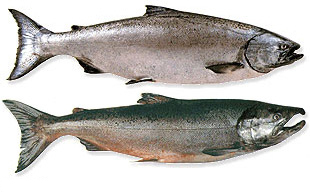 State biologists are forecasting a much leaner commercial salmon fishing season in Alaska this summer. Last year, fishermen caught 268 million salmon, according to the Alaska Department of Fish and Game. Biologists this year are expecting 161 million salmon to be harvested, a nearly 40 percent decline. The big drop is mostly due to fewer pink salmon expected to return. “Pinks typically have a strong year and then a weaker year. It’s an even-odd cycle. 2016 is an even year so we’ll have fewer pink salmon returning. That’s really what’s driving everything in that report,” said Richard Brenner, a fishery biologist who co-authored the report. Read the rest here 09:57
State biologists are forecasting a much leaner commercial salmon fishing season in Alaska this summer. Last year, fishermen caught 268 million salmon, according to the Alaska Department of Fish and Game. Biologists this year are expecting 161 million salmon to be harvested, a nearly 40 percent decline. The big drop is mostly due to fewer pink salmon expected to return. “Pinks typically have a strong year and then a weaker year. It’s an even-odd cycle. 2016 is an even year so we’ll have fewer pink salmon returning. That’s really what’s driving everything in that report,” said Richard Brenner, a fishery biologist who co-authored the report. Read the rest here 09:57
Gloucester: Proposed lobster ban would hurt local businesses
 Vince Mortillaro, one of the owners of the Gloucester-based family lobster business that bears his name, is watching the evolving trade dispute with Sweden and potentially the rest of the European Union over American lobsters and he doesn’t particularly like what he’s seeing. “We’re talking about a big chunk of everybody’s business,” Mortillaro said Tuesday when asked about Sweden’s attempt to convince the entire European Union — which numbers 28 member states — to ban the import of American lobsters to Europe. “Between the U.S. and Canada selling lobsters and the European Union buying and reselling them, we’re probably talking about a $1 billion business.” Read the rest here 09:27
Vince Mortillaro, one of the owners of the Gloucester-based family lobster business that bears his name, is watching the evolving trade dispute with Sweden and potentially the rest of the European Union over American lobsters and he doesn’t particularly like what he’s seeing. “We’re talking about a big chunk of everybody’s business,” Mortillaro said Tuesday when asked about Sweden’s attempt to convince the entire European Union — which numbers 28 member states — to ban the import of American lobsters to Europe. “Between the U.S. and Canada selling lobsters and the European Union buying and reselling them, we’re probably talking about a $1 billion business.” Read the rest here 09:27
Independent scientists need not apply – NMFS denies SMAST Industry paid RSA Funding
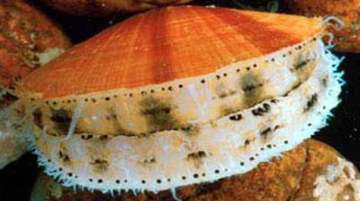 For almost 20 years now, SMAST has worked diligently alongside our fishermen to improve fishery science. Kevin’s research has earned him their respect, earned them a ton of money and earned New Bedford its position as the nation’s top fishing port. The drop camera survey he pioneered to count sea scallops on Georges Bank in 1999 was a game changer that helped to rescue an ailing industry. Anyone on the waterfront can attest to that. He did it by providing independent evidence that what fishermen had been saying was correct. There were plenty of scallops out there waiting to be harvested in spite of what the government survey would have everyone believe. Barney Frank took those survey pictures to Bill Daley, who was Secretary of Commerce at the time. Daley listened and New Bedford’s ship came in. It may now be departing. Read the op-ed here 07:27
For almost 20 years now, SMAST has worked diligently alongside our fishermen to improve fishery science. Kevin’s research has earned him their respect, earned them a ton of money and earned New Bedford its position as the nation’s top fishing port. The drop camera survey he pioneered to count sea scallops on Georges Bank in 1999 was a game changer that helped to rescue an ailing industry. Anyone on the waterfront can attest to that. He did it by providing independent evidence that what fishermen had been saying was correct. There were plenty of scallops out there waiting to be harvested in spite of what the government survey would have everyone believe. Barney Frank took those survey pictures to Bill Daley, who was Secretary of Commerce at the time. Daley listened and New Bedford’s ship came in. It may now be departing. Read the op-ed here 07:27
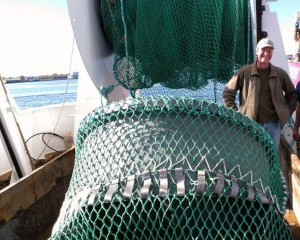
THIS IS OUTRAGEOUS! SMAST scallop researcher rejected for NOAA funding for first time since 1999
For the first time since 1999, internationally known SMAST scientist Kevin Stokesbury has been denied federally administered funding for annual scallop surveys, as government officials questioned the cost and design of his latest proposal. Many local fishermen credit Stokesbury’s work with reviving the scallop industry over more than a decade, and a prominent scalloper said Tuesday that it was hard to make sense of the funding denial this year. “We as an industry are very upset about this — it’s very disturbing,” said Dan Eilertsen, who owns six scallopers based on Fish Island. “Our fishery has been managed based on the published work that (Stokesbury) does.” The National Marine Fisheries Service, under the National Oceanic and Atmospheric Administration (NOAA), told Stokesbury on March 29 that his proposal for a $2.65 million scallop survey project had been denied for the 2016-17 grant cycle. Read the rest here 20:14
Bay de Verde fish plant will be rebuilt after huge fire, owners assure workers
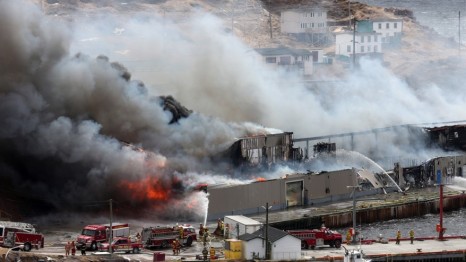 Hundreds of vital jobs also went up in those billows of black ash but owners the Quinlan Brothers offered some much needed reassurance. “There has been a great loss of physical assets but all of it can be and will be replaced,” the company said in a statement late Tuesday. “The company is fully insured and it will rebuild at Bay de Verde as quickly as possible.” It also said it can serve fish harvesters “as normal” with backup plans for processing. “The company is working ’round the clock to put in place arrangements with other producers to add capacity, increase shifts, etc., that will ensure seafood landed is processed in a timely and high quality manner.” Read the rest here 16:29
Hundreds of vital jobs also went up in those billows of black ash but owners the Quinlan Brothers offered some much needed reassurance. “There has been a great loss of physical assets but all of it can be and will be replaced,” the company said in a statement late Tuesday. “The company is fully insured and it will rebuild at Bay de Verde as quickly as possible.” It also said it can serve fish harvesters “as normal” with backup plans for processing. “The company is working ’round the clock to put in place arrangements with other producers to add capacity, increase shifts, etc., that will ensure seafood landed is processed in a timely and high quality manner.” Read the rest here 16:29
Chesapeake Bay blue crab population grows 35 percent; DNR predicts ‘robust’ season
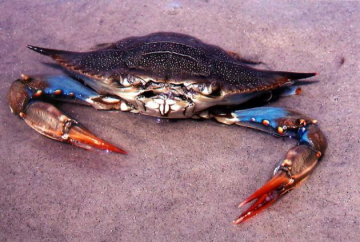 There are more than 550 million blue crabs in the Chesapeake Bay, an increase of more than a third over this time last year and one of the highest population counts of the past two decades. A winter dredging survey found the strongest growth in the populations of adult male crabs, which more than doubled. The number of spawning females, a key barometer for future population growth, nearly doubled but remained slightly below a target population count of 215 million.Maryland Department of Natural Resources officials, who released the survey results Tuesday, said the results bode well for local crab harvests. Read the rest here 15:53
There are more than 550 million blue crabs in the Chesapeake Bay, an increase of more than a third over this time last year and one of the highest population counts of the past two decades. A winter dredging survey found the strongest growth in the populations of adult male crabs, which more than doubled. The number of spawning females, a key barometer for future population growth, nearly doubled but remained slightly below a target population count of 215 million.Maryland Department of Natural Resources officials, who released the survey results Tuesday, said the results bode well for local crab harvests. Read the rest here 15:53
The “Zumwalt Effect”: New off-radar US destroyer poses maritime traffic risks
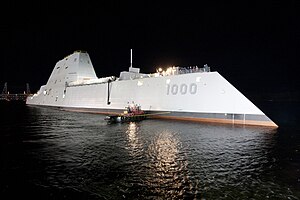 Ongoing at-sea tests of the most advanced and expensive destroyer ever, the USS Zumwalt (DDG 1000), have exposed an unexpected problem. Perceived as a medium-sized fishing boat on radars, its sheer size shocks ill-prepared fishermen when it approaches. Maine lobsterman Lawrence Pye experienced the “Zumwalt effect” for himself. He saw something that appeared on his radar screen to be a 15-meter fishing boat, but it materialized into a gigantic 186-meter warship. The destroyer was returning to the Bath Iron Works shipbuilding yard after a series of sea trials. Read the rest here 12:35
Ongoing at-sea tests of the most advanced and expensive destroyer ever, the USS Zumwalt (DDG 1000), have exposed an unexpected problem. Perceived as a medium-sized fishing boat on radars, its sheer size shocks ill-prepared fishermen when it approaches. Maine lobsterman Lawrence Pye experienced the “Zumwalt effect” for himself. He saw something that appeared on his radar screen to be a 15-meter fishing boat, but it materialized into a gigantic 186-meter warship. The destroyer was returning to the Bath Iron Works shipbuilding yard after a series of sea trials. Read the rest here 12:35
West Coast sardine fishery shutdown continues for 2nd year
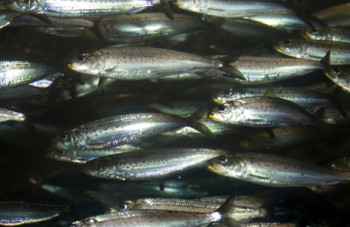 West coast sardine fishermen for a second straight season will have to keep their boats moored or find something else to catch. The Pacific Fishery Management Council on Sunday closed the sardine fishery off Oregon, California and Washington following the second straight year of sardine population estimates that fall below the minimum abundance required to allow fishing. There are fewer than 65,000 metric tons adult sardines in the ocean this year, federal scientists estimated. West coast fishery rules require sardine fishing to cease once the adult stock drops below 150,000 metric tons. Read the article here 11:58
West coast sardine fishermen for a second straight season will have to keep their boats moored or find something else to catch. The Pacific Fishery Management Council on Sunday closed the sardine fishery off Oregon, California and Washington following the second straight year of sardine population estimates that fall below the minimum abundance required to allow fishing. There are fewer than 65,000 metric tons adult sardines in the ocean this year, federal scientists estimated. West coast fishery rules require sardine fishing to cease once the adult stock drops below 150,000 metric tons. Read the article here 11:58
ADF&G Releases Bristol Bay Update
 A new forecast for the 2016 sockeye salmon fishing season in Bristol Bay says the fishery, which opens by regulation on June 1, is expected to have a run of some 46.6 million fish, with 29.5 million potentially available for commercial harvest. The figures were released on April 4 by the Alaska Department of Fish and Game. For the eastside districts, fishing will be allowed using a weekly schedule that will vary by district, to balance fishing opportunity with escapement in the early part of the season, particularly for Chinook salmon. In the Nushagak District, management of the king salmon fishery will govern fishing time in the early part of the season, followed by directed sockeye salmon management as abundance dictates. Read the rest here 10:01
A new forecast for the 2016 sockeye salmon fishing season in Bristol Bay says the fishery, which opens by regulation on June 1, is expected to have a run of some 46.6 million fish, with 29.5 million potentially available for commercial harvest. The figures were released on April 4 by the Alaska Department of Fish and Game. For the eastside districts, fishing will be allowed using a weekly schedule that will vary by district, to balance fishing opportunity with escapement in the early part of the season, particularly for Chinook salmon. In the Nushagak District, management of the king salmon fishery will govern fishing time in the early part of the season, followed by directed sockeye salmon management as abundance dictates. Read the rest here 10:01
Congressman Jones opposes expansion of Monitor Marine Sanctuary
 Last week, U.S. Rep. Walter B. Jones, R-N.C., joined Dare and Carteret counties in opposing the National Oceanic and Atmospheric Administration’s (NOAA) proposed expansion of the Monitor Sanctuary off the Eastern North Carolina coast. The existing sanctuary protects the remains of the USS Monitor, a Civil War ironclad that sank in December 1862 off of Cape Hatteras. In January, NOAA published proposals to significantly expand the Monitor Sanctuary. Dare and Carteret counties subsequently passed public resolutions opposing expansion because of concerns they may be used in the future to restrict public access to large areas of federal waters off the North Carolina coast. “There is no need for new designations or access restrictions for fishermen and boaters that may flow from them in the future,” said Congressman Jones. Read the rest here 09:33 Read Monitor National Marine Sanctuary Expansion: The controversy continues, click here
Last week, U.S. Rep. Walter B. Jones, R-N.C., joined Dare and Carteret counties in opposing the National Oceanic and Atmospheric Administration’s (NOAA) proposed expansion of the Monitor Sanctuary off the Eastern North Carolina coast. The existing sanctuary protects the remains of the USS Monitor, a Civil War ironclad that sank in December 1862 off of Cape Hatteras. In January, NOAA published proposals to significantly expand the Monitor Sanctuary. Dare and Carteret counties subsequently passed public resolutions opposing expansion because of concerns they may be used in the future to restrict public access to large areas of federal waters off the North Carolina coast. “There is no need for new designations or access restrictions for fishermen and boaters that may flow from them in the future,” said Congressman Jones. Read the rest here 09:33 Read Monitor National Marine Sanctuary Expansion: The controversy continues, click here
MFV Louisa Fisherman Lachlann Armstrong’s battle for survival: “I didn’t know if I’d make it”
 A fisherman who swam through icy waters and clung onto rocks after his boat sank off the Outer Hebrides has spoken of his dramatic battle for survival and the “heartbreaking” moment he realised his friends were lost. Lachlann Armstrong admitted last night he did not know if he would make it to shore after he abandoned the MFV Louisa’s life raft when it failed to inflate. The 27-year-old father said he decided to try to reach the shore to free up space on the semi-submerged raft and help save his colleagues. Yesterday, he opened his heart about the tragedy that has rocked the Western Isles. Read the rest here 08:35
A fisherman who swam through icy waters and clung onto rocks after his boat sank off the Outer Hebrides has spoken of his dramatic battle for survival and the “heartbreaking” moment he realised his friends were lost. Lachlann Armstrong admitted last night he did not know if he would make it to shore after he abandoned the MFV Louisa’s life raft when it failed to inflate. The 27-year-old father said he decided to try to reach the shore to free up space on the semi-submerged raft and help save his colleagues. Yesterday, he opened his heart about the tragedy that has rocked the Western Isles. Read the rest here 08:35
Bay de Verde residents in plant fire evacuation left to ‘pick up the pieces’
 Bay de Verde’s mayor says residents and workers will need to ‘pick up the pieces’ following a fire that destroyed the eastern Newfoundland community’s fish processing plant. This morning we still have a smouldering mess,” Mayor Gerard Murphy told CBC’s St. John’s Morning Show on Tuesday. About 12 hours earlier, Murphy lifted a state of emergency and evacuation order in his community that saw 300 homes emptied as firefighters battled the blaze at the Quinlan Brothers Ltd. plant. The fire was reported at 5:30 a.m. NT Monday, and Murphy said the site is still one of devastation and smoke. Read the rest here 07:59
Bay de Verde’s mayor says residents and workers will need to ‘pick up the pieces’ following a fire that destroyed the eastern Newfoundland community’s fish processing plant. This morning we still have a smouldering mess,” Mayor Gerard Murphy told CBC’s St. John’s Morning Show on Tuesday. About 12 hours earlier, Murphy lifted a state of emergency and evacuation order in his community that saw 300 homes emptied as firefighters battled the blaze at the Quinlan Brothers Ltd. plant. The fire was reported at 5:30 a.m. NT Monday, and Murphy said the site is still one of devastation and smoke. Read the rest here 07:59
Officials work to remove capsized boat near Ventura Harbor
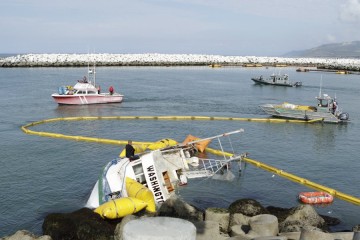 A boat remained partially submerged at the mouth of the Ventura Harbor on Monday after hitting the south end of the jetty while returning from a fishing expedition late Sunday night. Most of the 50-foot-long fishing vessel sank in shallow waters after hitting rocks along the jetty. Three people were rescued from the boat and one of them may have required medical care because of hypothermia, Brian Pendleton, business operations officer for the Ventura Port District, said on Monday as he stood on a balcony outside his office and looked across the harbor to the shipwrecked vessel. Read the rest here, 4 photo’s 19:56
A boat remained partially submerged at the mouth of the Ventura Harbor on Monday after hitting the south end of the jetty while returning from a fishing expedition late Sunday night. Most of the 50-foot-long fishing vessel sank in shallow waters after hitting rocks along the jetty. Three people were rescued from the boat and one of them may have required medical care because of hypothermia, Brian Pendleton, business operations officer for the Ventura Port District, said on Monday as he stood on a balcony outside his office and looked across the harbor to the shipwrecked vessel. Read the rest here, 4 photo’s 19:56
Federal fishery disaster money eased Alaska salmon fishery failures, but only for some
 The federal government’s help easing the impact of recent Alaska salmon fishery failures wasn’t enough to provide relief to all the players involved. Alaska initially received nearly $8 million in federal money after declaring a disaster in 2012 due to low king salmon runs on the Yukon and Kuskokwim rivers and in the Cook Inlet region. That’s according to a new study from the National Marine Fisheries Service, “Many commercial fishery stakeholders may have gotten little benefit from the relief payments because they were made to permit holders and may not have made their way to other key fishery participants,” it said. Those others include the nonpermit holding crew, vessel owners, suppliers of fishing inputs and owners, employees and suppliers of fish processing companies. Read the rest here 18:21
The federal government’s help easing the impact of recent Alaska salmon fishery failures wasn’t enough to provide relief to all the players involved. Alaska initially received nearly $8 million in federal money after declaring a disaster in 2012 due to low king salmon runs on the Yukon and Kuskokwim rivers and in the Cook Inlet region. That’s according to a new study from the National Marine Fisheries Service, “Many commercial fishery stakeholders may have gotten little benefit from the relief payments because they were made to permit holders and may not have made their way to other key fishery participants,” it said. Those others include the nonpermit holding crew, vessel owners, suppliers of fishing inputs and owners, employees and suppliers of fish processing companies. Read the rest here 18:21
Bodega Bay Fisherman’s Festival celebrates, blesses a busy fleet
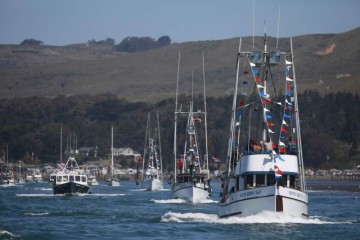 More than 20 vessels on Sunday were blessed by local clergy as part of the Bodega Bay Fisherman’s Festival, continuing a more than 50-year tradition in support of a key economic engine in this small coastal town. However, most commercial fishermen weren’t around to receive such divine words of encouragement. They instead were scrambling to make up for the late start to the Dungeness crab season, which began less than two weeks ago, instead of the typical starting time in mid-November. “Most of the (commercial) guys are fishing today. Video, photo’s, read the article here 16:12
More than 20 vessels on Sunday were blessed by local clergy as part of the Bodega Bay Fisherman’s Festival, continuing a more than 50-year tradition in support of a key economic engine in this small coastal town. However, most commercial fishermen weren’t around to receive such divine words of encouragement. They instead were scrambling to make up for the late start to the Dungeness crab season, which began less than two weeks ago, instead of the typical starting time in mid-November. “Most of the (commercial) guys are fishing today. Video, photo’s, read the article here 16:12
American-Canadian lobster industries digging in for a fight against E.U.lobster import ban
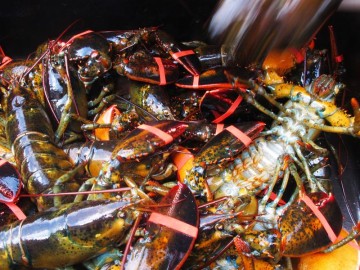 Exactly how 32 American lobsters wound up in Swedish waters isn’t clear. But because some of them were wearing the rubber bands that are put on lobsters’ claws in captivity, many suspect the shellfish had been exported to Europe and then either escaped into the wild or were set free by animal rights activists. Whatever the case, their discovery has set off a high-stakes trade dispute between Sweden on one side and the U.S. and Canada on the other. Sweden has asked the European Union to bar imports of live American lobsters into the 28-nation bloc, saying the crustaceans could spread disease and overwhelm the smaller European variety by outcompeting them for food. Read the article here 15:40
Exactly how 32 American lobsters wound up in Swedish waters isn’t clear. But because some of them were wearing the rubber bands that are put on lobsters’ claws in captivity, many suspect the shellfish had been exported to Europe and then either escaped into the wild or were set free by animal rights activists. Whatever the case, their discovery has set off a high-stakes trade dispute between Sweden on one side and the U.S. and Canada on the other. Sweden has asked the European Union to bar imports of live American lobsters into the 28-nation bloc, saying the crustaceans could spread disease and overwhelm the smaller European variety by outcompeting them for food. Read the article here 15:40
North Carolina Fisheries Association Weekly Update for April 11, 2016
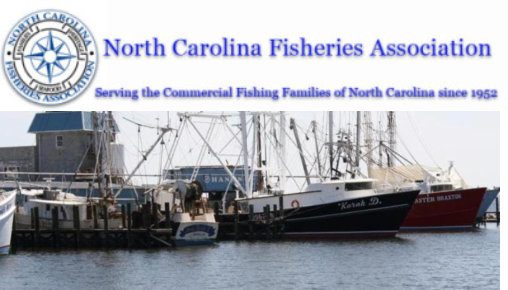 Click here to read the Weekly Update, to read all the updates, Click here 15:05
Click here to read the Weekly Update, to read all the updates, Click here 15:05






